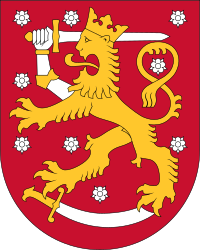Coat of arms of Finland
| Coat of arms of Finland | |
|---|---|
 |
|
| Details | |
| Armiger | Republic of Finland |
| Adopted | First documented in the 1580s. Current version official since 1978. |
| Escutcheon | Gules, semy of roses argent, a lion rampant crowned Or trampling a sabre in base proper, his dexter foreleg in the form of a man's arm vambraced and embowed argent garnished Or bearing aloft a sword proper. |
The coat of arms of Finland is a crowned lion on a red field, the right foreleg replaced with an armoured hand brandishing a sword, trampling on a sabre with the hindpaws. The coat of arms was originally created around the year 1580.
The heraldic lion originated from the Lion of Judea is quite common in Western Europe, and several European countries incorporate it into their national coats of arms. In Nordic heraldry, the lion is first found in the coat of arms of Denmark in the later part of the 12th century.
Starting in the 12th century, the territory of today's Finland was gradually incorporated into the Swedish kingdom, and this coincided with the period when coats of arms first came into use in northern Europe. The first known use of the lion in Sweden was on the royal seals of Erik Knutsson (died 1216) and Erik Eriksson (1216–50), who used two and three lions on their seal, respectively. The first king of the Folkunga family, Valdemar Birgersson (1239–1302), also used 3 lions on his seal (Figure 2).
Bengt Birgersson, the first Duke of Finland (1254–91, Duke from 1284 until 1291), and Valdemar Magnusson, the second Duke (died 1318, Duke of Finland from 1302 until 1317), both used the later Folkunga coat of arms, which was a crowned lion rampant with three bends sinister, the main difference being that Valdemar's arms had the field strewn with hearts (Figure 3). This version of the arms was quite similar to the modern coat of arms of Finland, but the lion did not yet brandish any weapon.
When John III assumed the title of "Grand Duke of Finland and Karelia", shortened to Grand Duke of Finland in 1577 (or soon thereafter), the lion became closely associated with Finland through the grand-ducal coats of arms (Figure 5). The grand-ducal coat of arms is thought to have resulted out of a combination of the Göta lion (originating from the Folkunga lion) and the arms of Karelia (Figure 6). The result was that the lion brandishes one weapon and treads on another.
...
Wikipedia
